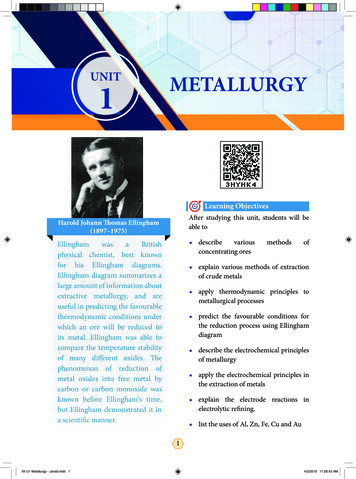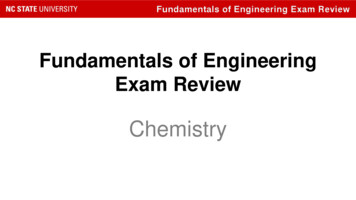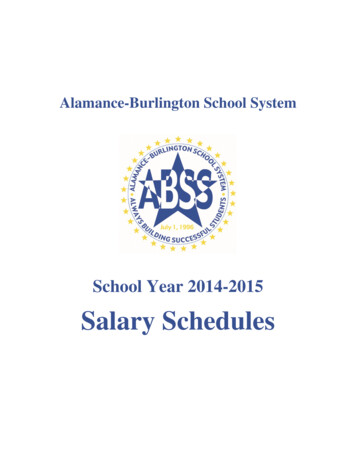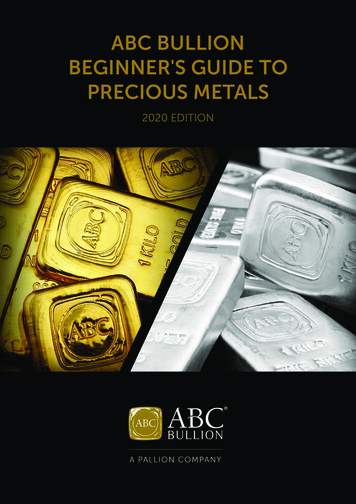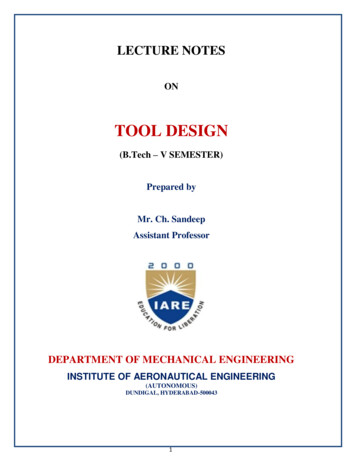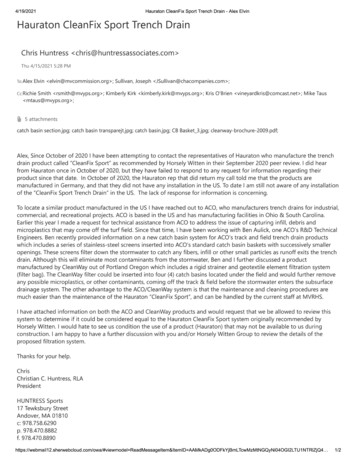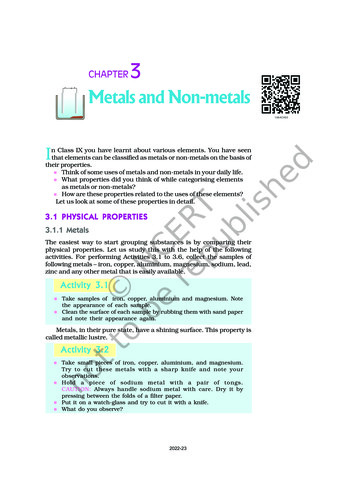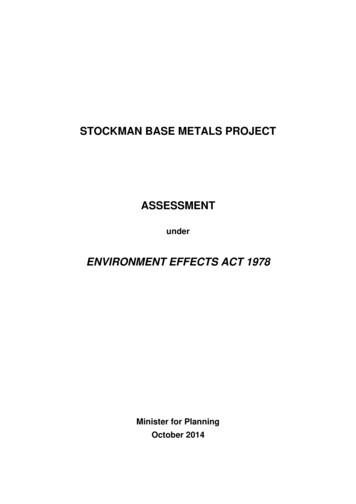
Transcription
STOCKMAN BASE METALS PROJECTASSESSMENTunderENVIRONMENT EFFECTS ACT 1978Minister for PlanningOctober 2014
GLOSSARYAH ActAMDC&LPCFACHMPCRGDEPIDoEDPIDSDBIDSEEE ActEESEMFEMSEPAEP ActEPBC ActEQOERRESDEVCFFG ActGDEGMWHa, HhaITRkmLOTMLAMOUMRSD ActNAFNECMANVMFPAFP&E ActPCMPPCTFPMFPSASEPPSMZSPZSRWTSFAboriginal Heritage Act 2006Acid and metalliferous drainageCatchment and Land Protection Act 1994Country Fire AuthorityCultural Heritage Management PlanCommunity Reference GroupDepartment of Environment and Primary IndustriesCommonwealth Department of the Environmentformer Department of Primary IndustriesDepartment of State Development, Business and Innovationformer Department of Sustainability and EnvironmentEnvironment Effects Act 1978Environment Effects StatementEnvironmental Management FrameworkEnvironmental Management SystemEnvironment Protection AuthorityEnvironment Protection Act 1970Environment Protection and Biodiversity Conservation Act 1999Environmental Quality ObjectiveEarth Resources Regulationecologically sustainable developmentEcological Vegetation ClassFlora and Fauna Guarantee Act 1988Groundwater Dependant EcosystemsGoulburn Murray Waterhectare, Habitat hectareIndependent Technical ReviewkilometreLarge Old TreeMining Licence AreaMemorandum of UnderstandingMineral Resources (Sustainable Development) Act 1990Not acid formingNorth East Catchment Management AuthorityVictoria’s Native Vegetation Management FrameworkPotentially acid formingPlanning and Environment Act 1987Post-closure Monitoring PlanPost-closure Trust FundProbable maximum floodPlanning Scheme AmendmentState Environment Protection PolicySpecial Management ZoneSpecial Protection ZoneSouthern Rural Watertailings storage facilityii
TABLE OF CONTENTS1INTRODUCTION .11.1Purpose of this document. 11.2Project Description . 11.3Structure of this Assessment . 22STATUTORY PROCESSES .42.1Environment Effects Act 1978 . 42.2Victorian Statutory Approvals . 42.3Commonwealth Statutory Approval . 43SUMMARY OF KEY FINDINGS .54INTEGRATED ASSESSMENT .654.1Approach to this Assessment . 64.2Project Alternatives . 74.3Best Use of Mineral Resources . 104.4Biodiversity and Habitat . 114.5Catchment Values . 184.6Rehabilitation and Post-Closure . 304.7Planning, Land Use and Amenity . 334.8Socio-economic . 364.9Cultural Heritage . 384.10Environmental Management Framework . 394.11Governance Framework . 414.12Ecologically Sustainable Mining . 43RESPONSE TO INQUIRY RECOMMENDATIONS .46iii
1 INTRODUCTION1.1 Purpose of this documentThis is the assessment of environmental effects (Assessment) under the Environment Effects Act 1978 (EE Act) for theStockman Base Metals Project (the ‘Project’). It represents the final step in the Environment Effects Statement (EES)process under the EE Act by which the Minister provides advice to decision-makers on the likely environmental effects ofthe proposal, their acceptability and how they should be addressed in relevant statutory decisions. The Assessment isinformed by the report of the Inquiry together with the EES and public submissions.This Assessment will inform the decisions required under Victorian law for the proposal to proceed, in particular underthe Mineral Resources (Sustainable Development) Act 1990 (MRSD Act) and Planning and Environment Act 1987 (P&EAct). It will also inform the approval decision under the Commonwealth Environment Protection and BiodiversityConservation Act 1999 (EPBC Act).1.2 Project DescriptionStockman ProjectStockman Project Pty Ltd, a wholly owned subsidiary of Independence Group NL, proposes to recommission an existingunderground mine (Wilga) and develop a new underground mine (Currawong) within State Forest, approximately 19kilometres (km) south-east of Benambra in East Gippsland (see Figure ). Approximately nine million tonnes of ore areproposed to be mined from underground to produce about 150,000 tonnes per year of copper-zinc-silver-goldconcentrates for export over a projected nine year operating life. Tailings from ore processing would be returnedunderground as backfill and stored above ground in a dedicated tailings storage facility (TSF) with a permanent watercover. The preferred location for the TSF is the site previously used by Denehurst Ltd when it operated the BenambraProject, now known as Lake St Barbara.The Project would require a range of on- and off-site ancillary infrastructure to support the mine operation, including aprocessing plant, access roads, pipelines, water supply infrastructure, electricity supply infrastructure, road upgradesand worker accommodation village. A detailed description of the Project is provided in Chapter 4 of the EES.Previous Benambra ProjectLegacy issues remain within the project area due to a previous mining project (Benambra Project). As this significantlyinfluenced some of the existing conditions within the project area, it is beneficial to outline the history of this previousproject.The Benambra mine, operated by Denehurst Ltd from 1992 to 1996, involved the partial mining of the Wilga deposit. In1996, the mine was placed into administration and mining operations ceased prior to the undertaking of anyenvironmental rehabilitation. Following this, in 1998 the company went into administration. In it’s four years of operations,the mine processed 927,000 tonnes of ore producing copper and zinc concentrates along with nearly 700,000 tonnes ofsulfidic tailings that were deposited to the TSF via a single spigot point located in the north-eastern section of the TSF.Due to the uneven distribution of tailings in some areas of the TSF, tailings became exposed above the supernatantwater during prolonged periods of dry weather1. In addition, it is understood that in March 1996, approximately 17 tonnesof sulphuric acid was added to the TSF supernatant water to lower the pH and enhance copper recoveries, as thesupernatant water was recycled back to the processing plant via a closed loop. This resulted in the pH dropping rapidlyto approximately 3 by November 19962.1EES Appendix B1, p. 172EES Appendix B1, p. 181
In 2004, the mining lease expired and the site reverted to the State Government of Victoria. The then Department ofPrimary Industries (DPI) commissioned work to rehabilitate the site. Rehabilitation as described in the EES3 wassuccessfully implemented in 2006 such that the TSF was renamed Lake St Barbara to reflect it’s changed status4.In addition to this, the former processing site was decommissioned with all infrastructure removed with the exception ofconcrete foundations, however this site is also known to have some contamination from previous operations.Monitoring at the Wilga mine post closure has confirmed a low rate of groundwater inflow into the discussed mine5.Whilst rehabilitation efforts have been quite successful, the following issues remain features of the existing conditions,which will remain regardless of whether the Stockman Project proceeds: Ongoing risk to environment presented by existing TSF/Lake St BarbaraRemediation required at the former processing plant site to clean up land contaminationCurrent seepage from TSF at approximately 0.6 L/s6.1.3 Structure of this AssessmentSection 2 of this Assessment outlines both the EES process and statutory approvals required for the proposeddevelopment. Section 3 provides an outline of the key conclusions of the assessment.The core part of this Assessment is found in Section 4, which assesses the environmental effects of the project based onthe applicable legislative and policy framework. Section 4 also outlines the evaluation objectives for this Project,including the relevant objectives and principles of ecologically sustainable development (ESD), which are used tostructure the integrated evaluation of the environmental effects within this document.Section 5 provides responses to the recommendations of the Inquiry.3EES Appendix B1, p. 21 to 224EES Appendix B1, p. 21 to 225Inquiry Report p. 446EES p. 10-52
Figure 1. Stockman Base Metals Project location3
2 STATUTORY PROCESSES2.1 Environment Effects Act 1978On 16 August 2010, the former Minister for Planning determined that an EES was required for the project under the EEAct. The EES has been prepared by the proponent in response to Scoping Requirements issued by the Minister for theproposal in March 2011.The EES was placed on public exhibition, together with draft amendment to the East Gippsland Planning Scheme anddraft Work Plan, from 25 March 2014 until 8 May 2014. Thirty six submissions were received, ten of which were fromstate and local government bodies. Details of submitters are included in Appendix B of the Inquiry Report.The Minister appointed an Inquiry under the EE Act to review submissions and inquire into the environmental effects ofthe Project, in accordance with terms of reference issued by the Minister on 15 April 2014. The Minister also appointedthe Inquiry members as an Advisory Committee under section 151 of the P&E Act to consider the draft planning schemeamendment (PSA) and related matters raised in submissions.The Inquiry held a directions hearing on 20 May 2014, followed by its public hearing over six days from 23 to 30 June2014. The Inquiry provided its report to the Minister on 2 September 2014. The report has informed the preparation ofthis Assessment of the environmental effects of the Project under the EE Act.The next step is the provision of this Assessment to statutory decision-makers, who must consider it before decidingwhether to grant approval to the Project.2.2 Victorian Statutory ApprovalsThe Project requires a number of Victorian statutory approvals, including: A Mining Licence or mining infrastructure licence under the MRSD Act for the area currently excluded from thecurrent Mining Licence area (MLA). The excluded area includes the existing TSF known as Lake St Barbara.Despite this distinction, for ease of reference the rest of this assessment will treat the “Stockman MLA” asincluding Lake St Barbara as it is certain that if the project goes ahead, this area will be regulated under theMRSD Act. Work Plan and Work Authority under the MRSD Act7. Amendment to the East Gippsland Planning Scheme under the P&E Act for project infrastructure located onland outside the Stockman MLA. Permits under the Water Act 1989 to take and use water and for works on a waterway. Works Approvals for a proposed power generation facility and sewage treatment plant under the EnvironmentProtection Act 1970 (EP Act). Permits/licences to remove native vegetation under the Flora and Fauna Guarantee Act 1988 (FFG Act). An approved Cultural Heritage Management Plan (CHMP) under the Aboriginal Heritage Act 2006 (AH Act).Exhibition of draft PSA and draft Work Plan was coordinated with the exhibition of the EES for the Project.2.3 Commonwealth Statutory ApprovalOn 29 November 2010, the delegate of the Australian Government Minister for Environment, Water, Heritage and theArts decided that the proposal is a ‘controlled action’ (EPBC 2010/5717) and therefore requires assessment andapproval under the EPBC Act. The controlling provisions under the EPBC Act relate to listed threatened species andcommunities (section 18 and 18A).The Victorian EES process is accredited as the necessary Commonwealth assessment process through a BilateralAgreement between Victoria and the Commonwealth, made under Section 45 of the EPBC Act. Therefore, the EES forThe present requirement for a work authority will no longer apply when the repeal of the relevant provisions of the MRSD Actcomes into effect on 1 November 2014.74
the Project and this Assessment evaluate potential impacts on matters of national environmental significance as definedunder the EPBC Act, and will inform the Australian Government’s approval decision under the EPBC Act.3 SUMMARY OF KEY FINDINGSDuring the EES process it became apparent that the key risks to and effects on environmental assets from the Projectarose primarily due to the potentially acidic nature of the tailings material to be generated and needing to be managedand stored, as well as the proposed footprint of the TSF. These hazards give rise to potentially significant effects andrisks for biodiversity and downstream catchment values in particular. The tailings management strategy, includingalternative locations for the TSF, were therefore identified as key matters to be examined during the EES and haveshaped the Inquiry report and the structure and focus of this Assessment.The Stockman Project will result in significant direct and indirect effects on biodiversity, primarily through clearing almost70 hectares (ha) of native vegetation and 600 large old trees (LOTs) of which 90% is of very high or high conservationsignificance, supporting habitat values of a number of listed threatened and endangered species. However, asconcluded by the Inquiry, the losses are considered acceptable in the context of the policy framework with appropriateoffsets and mitigation in place. Provided the findings of this Assessment, as set out in the following sections, areimplemented and offsets and mitigation are effective, the biodiversity effects of this Project should be acceptable.Other significant environmental risks, in particular for catchment values, are associated with acid and metalliferousdrainage (AMD) and the TSF. These risks should be managed with the assistance of a robust governance framework,including independent technical review of key aspects of the Project. However, as noted in the sections below, AMDrepresents a significant environmental challenge for the project that necessitates best practice engineering and designwhich, together with ongoing risk management, needs to be effective to address environmental security, includingfollowing closure of the mine and the TSF. This Assessment concludes that AMD-related risks are indeed significant,although they should be appropriately managed and will be subject to careful consideration by independent reviewersand regulators in assessing final applications, for the TSF construction in particular.5
4 INTEGRATED ASSESSMENT4.1 Approach to this AssessmentTo provide a coherent and integrated structure for this Assessment of likely adverse environmental effects, the keyaspects of relevant legislation, statutory policy and the principles and objectives of ESD8 have been synthesized into aset of evaluation objectives that are pertinent to the Project. A draft set of evaluation objectives was included in theScoping Requirements for this EES, which were used by the proponent in their assessment of alternatives and effectswithin the EES.Table 1 lists the final set of evaluation objectives used in this Assessment and the core legislation that underpins them.Table 1. Assessment Evaluation ObjectivesEvaluation ObjectivesBest use of mineral resources - To enable an economically viable mining project that makes thebest use of mineral resources.Key LegislationMRSD ActBiodiversity and habitat - To avoid, minimise and mitigate effects on flora and fauna species andecological communities, in particular those listed under the FFG Act and/or the EPBC Act, as wellas to comply with the requirements for native vegetation under Victoria’s Native VegetationManagement – A Framework for Action.P&E ActFFG ActEPBC ActWildlife Act 1975Catchment values - To protect catchment values and beneficial uses, in particular surface andgroundwater quality, stream flow and aquatic health including through the provision of appropriatelong-term management and storage of waste rock and tailings and optimising water use.EP ActWater ActP&E ActC&LP ActMRSD ActP&E ActC&LP ActEP ActP&E ActEP ActMRSD ActP&E ActMRSD ActRehabilitation and post-closure - To provide appropriate measures to ensure the effectiverehabilitation of the project site and to ensure the ongoing protection of environmental values inperpetuity.Planning, Land use and Amenity – To deliver a project that addresses the planning objectives ofthe region and to avoid or minimise adverse effects on amenity and present and future land uses.Socio-economic effects - To minimise potential adverse social and economic effects andmaximise potential socio-economic benefits, including in relation to affected townships, residents,community services and infrastructure both during project operations and following closure.Cultural heritage - To protect Aboriginal and historic cultural heritage values.Environmental management framework - To provide a transparent framework with clearaccountabilities for managing environmental effects and hazards associated with the project inorder to achieve acceptable environmental outcomes.Governance framework – to establish a transparent and robust framework for the governanceand oversight of the project from pre-approval to post-construction.Ecologically sustainable mining - Overall, to enable a mining development that contributes tothe economic, social and environmental objectives of the State, consistent with the principles ofecologically sustainable development and environment protection.AH ActHeritage Act 1995P&E ActMRSD ActP&E ActEP ActAH ActEPBC ActMRSD ActP&E ActEP ActMRSD ActP&E ActEP ActEPBC ActSee Ministerial guidelines for assessment of environmental effects under the Environment Effects Act 1978 made under section 10of the EE Act, pp. 19 and 27.86
4.2 Project AlternativesAs set out in the Scoping Requirements and the procedures and requirements the former Minister issued under the EEAct for the Project, this EES was required to describe and assess relevant alternatives for particular project components,identify the environmental effects of each alternative and explain why the preferred alternative was selected. As with thestudy of environmental effects, the assessment of alternatives was necessarily risk-based9 in nature. Many alternativeswere considered for different aspects of the project, as described in Chapter 5 of the EES. This assessment will focuson the alternatives that relate to the key environmental risks, in particular those aimed at reducing the most significanteffects (AMD and broad scale clearing of significant vegetation), which were flagged as priorities in the initial referral ofthe project and the Minister’s decision to require an EES:A. (i) Tailings management and storage, including (ii) location of a TSF;B. Location(s) for other main project elements, including processing facility and accommodation village; andC. Project water and electricity supply sources and infrastructure locations.A(i) Tailings ManagementIn total, 25 options for tailings management, which fit within the Environment Protection Authority’s (EPA) wastemanagement hierarchy principles, were considered by the proponent, firstly by a semi-quantitative multi-criteria analysis.This resulted in 5 options being identified as feasible and worthy of further consideration through a detailed riskassessment10.The recommended management measures11 for avoiding AMD12 resulted in the preferred tailings management strategybeing identified, comprising of a combination of “reuse of tailings for structural stability of underground mining voids” and“storage of raw tailings in the existing TSF (to be expanded) under saturated conditions below a permanent minimum 2metre (m) water cover post-closure”13.The final project description included two scenarios: firstly for tailings to be stored 50% above and 50% below ground;and secondly, a worst case scenario in terms of above ground footprint for 100% tailings to be stored above ground. Theproponent seeks approval for the ability to develop both of these scenarios, as the ability to develop the appropriatepaste for underground storage and the final volume that could be stored underground is somewhat uncertain.Provided water supply is assured, a permanent water cover for tailings is recognised as the best practice method torestrict exposure of these reactive wastes. This may be in an above ground storage facility or underground mine voidsdepending on site characteristics and the potential for underground storage to sterilise future ore14.The Inquiry accepted the evidence provided that this is the most appropriate storage method for the Stockman Project15.They also concluded that the volume of tailings stored underground should be maximised given it is preferential to havelong term storage of tailings underground rather than above ground, as advised by Dr Taylor16 and illustrated by theproject-wide risk assessment, which showed post-closure risk of AMD from mine voids is significantly smaller than risksassociated with the above-ground TSF17. The feasible means by which this can be achieved requires furtherinvestigation, including to ensure long term risks to groundwater quality are acceptable.9 The Ministerial Guidelines define ‘environmental risk’ as the potential of negative change, injury or loss with respect to environmental assets. Thelevel of environmental risk will reflect the combination of likelihood and magnitude, as well as extent and duration, of potential environmentaleffects. EES documentation should be prepared in the context of the principle of proportionality to risk. ‘A risk-based approach should be adopted inthe assessment of environmental effects so that suitable, intensive, best practice methods can be applied to accurately assess those matters thatinvolve relatively high levels of risk of significant adverse effects and to guide the design of strategies to manage these risks’10 EES Appendix B1, p. 2711 as described in section 7.0 Appendix A to Appendix B112 Acid and metalliferous drainage (AMD): Soil and rock is often classed as either potentially acid forming (PAF) or not acid forming (NAF) due tothe presence or absence of sulphate. Where PAF material is present, there is a risk of AMD. AMD refers to problematic drainage related to theoxidation of sulphides in materials that are either exposed rock face or a by-product of mining (tailings). The AMD can display one or more of thefollowing chemical characteristics (fn DITR, 2007, section 2.2): low pH (from 1.5 to 4), high soluble metal concentrations (e.g., iron, copper, lead),elevated acidity values, high (sulphate) salinity, low concentrations of dissolved oxygen, low turbidity or total suspended solids.13 Appendix B1 p. 7414 DITR, 2007 p. 56 – 5715 Inquiry Report p. 5016 EW, Inquiry Report p. 4817 EES Appendix C to Appendix U7
A (ii) Location of Tailings Storage FacilityA total of seven possible sites for the TSF were considered, as described in section 5.5.2 of the EES. The sevenlocations were the subject of a risk assessment (Appendix B2 of the EES). The risk assessment considered the followingeight risk events to be significant differentiators between the options18: Loss of water coverExcessive seepage of poor quality waterTailings or return water pipeline failureSeismic eventEmbankment overtopEmbankment pipingAmenityVegetation removal.The report identified two sites19 that had the lowest overall risk with the main differentiator being the risk associated withthe removal of 0.34 ha of endangered Sub-Alpine Wet Heathland being required at Lake St Barbara20. In addition to risk,estimated construction costs including contingencies were compared. Augmenting the existing TSF had a lowerconstruction cost and less contingency on account of the greater amount of historical and detailed data relating theunderlying geology of the site. Although there was no detailed investigations of the alternate site, it was considered thatcalcareous materials, and therefore cavities, may be present. The report concluded that augmenting Lake St Barbarawas the preferred option mainly due to the significant amount of historical information already available regarding the siteand how it operates as a system. This was seen as consistent with principles of risk management21.No submissions raised the chosen location of the TSF as an issue. Although some raised concern about the nativevegetation to be affected by the footprint (which is dealt with in section 4.4), the Department of Environment and PrimaryIndustries (DEPI) indicated the consideration of alternate configurations helped the proponent to adequately address thethree step approach under the Native Vegetation Management Framework.B. Locations for Main Project ElementsProcessing FacilityThree possible locations for the processing facility were considered including Waxslip Spur, the location of the formerprocessing facility, cleared farmland to the north of the mine site and a new location close to the Currawong mine. TheWaxslip Spur site is surrounded by very steep slopes and so the large amount of cut and fill earthworks required tocreate a sufficiently safe and level area caused this site to be discounted at the screening stage. The proponent howeverintends to use the existing cleared land at this site for a helipad and potentially for temporary soil stockpiles22.The northern farmland option was located approximately 19.8 km from Wilga and 8 km from Currawong. Although thesite had the advantage of being almost entirely void of LOTs and a reduced bushfire risk, the additional haulage costsand risks of pipeline failure for the tailings to the TSF caused this site to be discounted as well.The preferred location at Currawong has the advantage of being close to the mine, reducing haulage costs and, due toits terrain, requires considerably less cut and fill than Waxslip Spur. This location will however require significantamounts of native vegetation to be cleared including many LOTs and very high quality habitat23, which is examinedfurther in section 4.4.18EES Appendix B2 p. 1119Lake St Barbara and a new site to the north-east of Lake St Barbara20EES Appendix B2, p. 1921AS/NZS ISO 31000:200922EES Main Report p. 5-923EES Main Report p. 5-108
Accommodation FacilityThe location of the worker’s accommodation village was carefully examined by the proponent during the EES process,including in relation to the Project achieving social benefits for the region. Two locations were considered, one near thetown of Benambra and one as close to the mine as possible. A comparative study of the two sites concluded thatlocating the village near Benambra was comparatively more consistent with planning policy, would reduce risks relatedto bushfire, and had more chance of avoiding potential impacts on native vegetation and cultural heritage. It also hadgreater potential to generate associated economic benefits for local businesses. From an operational perspectivehowever, the site closer to the mine performed better, providing easy access to the mine site allowing a 2 x 12 hour shiftrotation without impacting on worker attraction, as well as providing the opportunity to control alcohol use to ensure‘fitness for work’. This site also provided additional occupational health and safety benefits, reducing the potential forfatigue, fatigue-related incidents and road accidents.Council’s presentation to the Inquiry24 identified the location of the workers village as one of the more difficult andcontentious matters to decide upon. Indeed, while the Council now broadly supports the location close to the mine, itinitially strongly supported the Benambra location, believing it would provide superior social and economic benefits to thelocal area. In the end, the Council accepted the operational imperatives of the mine and acknowledged the real ‘issue’being to ensure ‘company operating policies and procedures for managing and encouraging appropriate communityinteractions that would determine successful outcomes for both the mine and the community’25.Whilst acknowledging ‘conventional wisdom would support town based accommodation’ the Inquiry accepted theconsidered analysis of the merits in the EES documentation and endorsed the ult
A detailed description of the Project is provided in Chapter 4 of the EES. Previous Benambra Project Legacy issues remain within the project area due to a previous mining project (Benambra Project). As this significantly influenced some of the existing conditions within the project area, it is beneficial to outline the history of this previous

